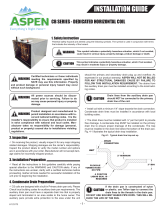1. If the furnace and air conditioner are on separate
thermostats, turn the furnace thermostat to the OFF position
during the cooling season to prevent simultaneous operation
of the heating and cooling systems. Reverse the procedure
during the heating season.
Set the desired temperature on your thermostat temperature
dial and set the fan switch to ON (for continuous air
circulation) or to AUTOMATIC (for air circulation only when
the air conditioning system is operating). If you desire to vary
the thermostat temperature setting during the day for energy
conservation (for example, while you are at work), do not
vary the setting more than 5 degrees of your normal
temperature setting. Changing the temperature more than 5
degrees or turning the thermostat off for periods less than 12
hours can actually cost you more in energy consumption
than keeping the temperature constant. You should also
consider indoor plants and pets when varying the
temperature from the normal comfort level.
2.
IMPORTANT: Wait at least 3 minutes after turning the
air conditioner off before trying to restart. If an attempt is
made to start the compressor before the refrigerant
pressures are equalized, the compressor motor may trip on
its overload. An additional waiting period will be required
before restarting.
3
OPERATION INSTRUCTIONS
1. Always install and keep filters clean. Check filters every 10
days to 2 weeks. Clean or replace if necessary.
2. Keep the condenser (outdoor coil) clean. Wash it down with
a garden hose if necessary. BE SURE THE UNIT
DISCONNECT IS IN THE “OFF” POSITION AND THAT ALL
ELECTRICAL POWER TO THE UNIT IS TURNED “OFF”
BEFORE CLEANING THE SYSTEM.
Remove any loose grass, leaves, papers, etc., from the area
around the condenser coil. These could reduce the air
supply through the coil and reduce the amount of cooling.
3. Since the air conditioner is located outdoors, it is exposed to
all weather elements. Treat it with a good automobile paste
wax twice a year (in the spring and fall).
WARNING:
SERIOUS PERSONAL INJURY OR
DEATH MAY RESULT IF WATER SPRAY IS
DIRECTED TOWARD LIVE ELECTRICAL CON-
NECTIONS OR POWER SOURCES.
!
MAINTENANCE INSTRUCTIONS
The condensing unit should be located outdoors as close as
possible to the evaporator. Consider the following factors:
1. The air inlet SHALL be located at least 12" from a wall or
other obstruction for unrestricted air flow.
2. The air outlet SHALL be located so as to direct discharged
air away from the building. (Avoid low overhanging roofs to
avoid recirculation of condenser discharge air on vertical
discharge models.)
3. Mount the unit on a sturdy base approximately 4" to 6" above
the ground. A concrete slab is recommended. If concrete
blocks are used, be sure to use well-tamped gravel-fill
beneath the blocks to prevent settling. If timbers are used, use
at least 6" x 6" timbers plus gravel-fill to prevent settling.
4. A concrete slab should not be in contact with the building
foundation to prevent possible sound or vibration
transmission.
5. Locating the condenser as close as possible to the
evaporator will increase the system capacities by reducing
the line set refrigerant pressure drop, and will make the
system less susceptible to liquid migrations due to less
refrigerant charge.
6. If practical, unit should be located on the south side of the
structure away from northerly winds to minimize the effects
of blowing snowdrifts and freezing rain. A wind screen or
wind block can also be used. In areas known for snow
accumulation, the unit should be elevated at least 18" above
the ground.
7. Placement of the unit should be in a well-drained area, or the
unit MUST be supported high enough so run-off will not
enter the unit.
8. Avoid installations under roof overhangs without guttering.
Water draining from the roof onto the unit could produce
excessive noise and may cause ice to build up on the coil or
fan during cold weather.
9. Do not locate where heat, lint or exhaust fumes will be
discharged on the unit (as from dryer vent). Rooftop
installation is acceptable in areas of low snow accumulations
provided the roof will support the unit and provisions are
made for water drainage and the noise or vibration through
the structure.
INSTALLATION
CODES: The installer SHALL comply with all local, state, and federal codes and/or regulations pertaining to this type of equipment and
its installation. Such codes and/or regulations should take precedence over any recommendations contained herein in lieu of local codes.
Installations SHALL be made in accordance with the National Electrical Code, local codes and recommendations made by the National Board
of Fire Underwriters.
CONDENSING UNIT










